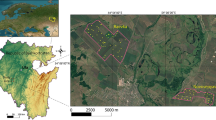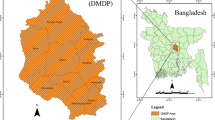Abstract
Soil mantles in the Western Ghat regions of South India are so thick that their properties cannot be investigated with the common soil exploration programs. The present work has been accomplished using data from boreholes dug for the purposes of a hydro-power project and from the samples collected at deep road cuttings in an upland area in Karnataka. While the data from boreholes have furnished information on soil depth and permeability, field studies have made known soil texture and density. Ring infiltration tests have been carried out to cross-check the coefficient of permeability values measured in the laboratory. It has been inferred that the soil depth generally varies from a couple of meters near the stream sides to about 20 m near hill tops and to over 50 m sometimes in the mid-slope region. No other factor seems to influence the soil thickness. Texture is found to vary between Silty sand and Sandy silt. Silt being the predominant component and clay content being low, the soil mantles are found to be highly stable. Measured values of permeability being very low compared to the measured infiltration rates, even on the forest floors, it is concluded that the size of the core samples is insufficient to capture the preferential flow paths that characterize this land.




Similar content being viewed by others
References
M.R.Y. Putty, R. Prasad, Understanding runoff processes using a Watershed model—a case study in Western Ghats in South India. J. Hydrol. 228(215), 227 (2000)
M.R.Y. Putty, Research Needs in Special Areas—The Case of Western Ghats. Souvenir and book of abstracts, in International Conference on Water Resources, Coastal and Ocean Engineering (ICWRCOE 2015), NITK, Surathkal, Karnataka, India. March, (2015), pp. 50–53
M.R.Y. Putty, R. Prasad, Runoff process in head water catchments—an experimental study in Western Ghats, South India. South India. J. Hydrol. (Netherlands) 235(2000), 63–70 (2000)
M.P. Mosley, Streamflow generation in a forested Watershed. N. Z. Water Resour. Res. 15(4), 795–806 (1979)
J.A.A. Jones, Extending the Hewlette model of stream runoff generation. Area 11(2), 110–114 (1979)
K.S. Sajinkumar, S. Anbazhagan, A.P. Pradeepkumar, V.R. Rani, Weathering and landslide occurrences in parts of Western Ghats, Kerala. J. Geol. Soc. India 78, 249–257 (2011)
M.R.Y. Putty, B.N. Prithviraj, N.P. Kumar, M.G. Nithish, G. Giri, P.N. Chandramouli, An insight into the hydrological aspects of landslides of 2018 in Kodagu, South India. Landslides. J. Int. Consort. Landslides. ISSN 1612-510X, (2021). https://doi.org/10.1007/s10346-020-01589-y
M.R.Y. Putty, C.G. Madhusoodhanan, Water resources and hydrology of the Western Ghats: their role and significance in South India. NNRMS Bull. ISRO 2013, 57–66 (2013)
G. Bourgeon, Explanatory booklet on the reconnaissance soil map of forested area, western Karnataka and Goa. French institute, India, 1st edition, ISSN 0073-8344 (1989), p. 96
M.R.Y. Putty, B.K.K. Swamy, R. Prasad, A study on infiltration rates in a very wet zone of the Western Ghats. Hydrol. J. IAH 20(1–4), 1–17 (1997)
G.C. Satisha, Characterization of soils of Western Ghats in Dakshina Kannada District, Karnataka. Univ. Agric. Sci. Agropedology 4, 45–48 (1994)
M. Bonell, B.K. Purandara, B. Venkatesh, K. Jagdish, H.A.K. Acharya, U.V. Singh, R. Jayakumar, N. Chappell, The impact of forest use and reforestation on soil hydraulic conductivity in the Western Ghats of India: Implications for surface and sub-surface hydrology. J. Hydrol. 391(1–2), 47–62 (2010)
S. Shougrakpam, R. Sarkar, S. Dutta, An experimental investigation to characterize soil macropores under different land-use practices of northeast India. J. Earth Syst. Sci. 119(5), 655–674 (2010)
M.J. Pavich, G.W. Leo, S.F. Obermeier, J.R. Estabrook, Investigations of the characteristics, origin, and residence time of the upland residual mantle of the Piedmont of Fairfax County, Virginia. USGS Prof. Paper—1352 (1989)
Acknowledgements
Some components of this study were accomplished as a part of a major project sponsored by the MoES, Govt. of India. A major part of the data on deep soil mantles has been made available by the Karnataka Power Corporation Ltd. The data on soil types at two sites in Kodagu have been furnished by the Dept. of Mines and Geology, Karnataka. The authors acknowledge with thanks the authorities concerned. The authors thank all those students of N.I.E., Mysuru, who have helped them on field.
Funding
No funding has been received specifically for carrying out this particular work and for publishing the paper. The paper includes results from work done over a duration of a decade.
Author information
Authors and Affiliations
Corresponding author
Ethics declarations
Conflict of interest
No conflict of interest is foreseen.
Additional information
Publisher's Note
Springer Nature remains neutral with regard to jurisdictional claims in published maps and institutional affiliations.
Rights and permissions
About this article
Cite this article
Putty, M.R.Y., Darshan, R., Kumar, N. et al. Soil Properties Influencing the Hydrology of Western Ghats: A Case Study in Karnataka. J. Inst. Eng. India Ser. A 102, 1161–1167 (2021). https://doi.org/10.1007/s40030-021-00574-5
Received:
Accepted:
Published:
Issue Date:
DOI: https://doi.org/10.1007/s40030-021-00574-5




